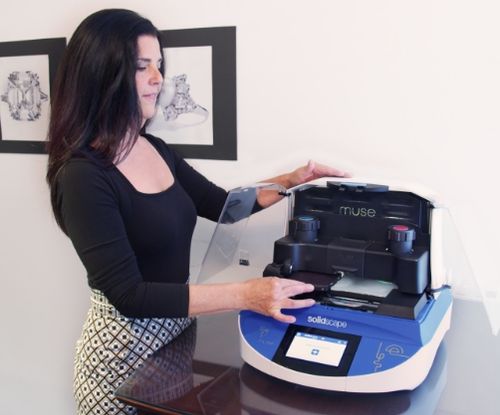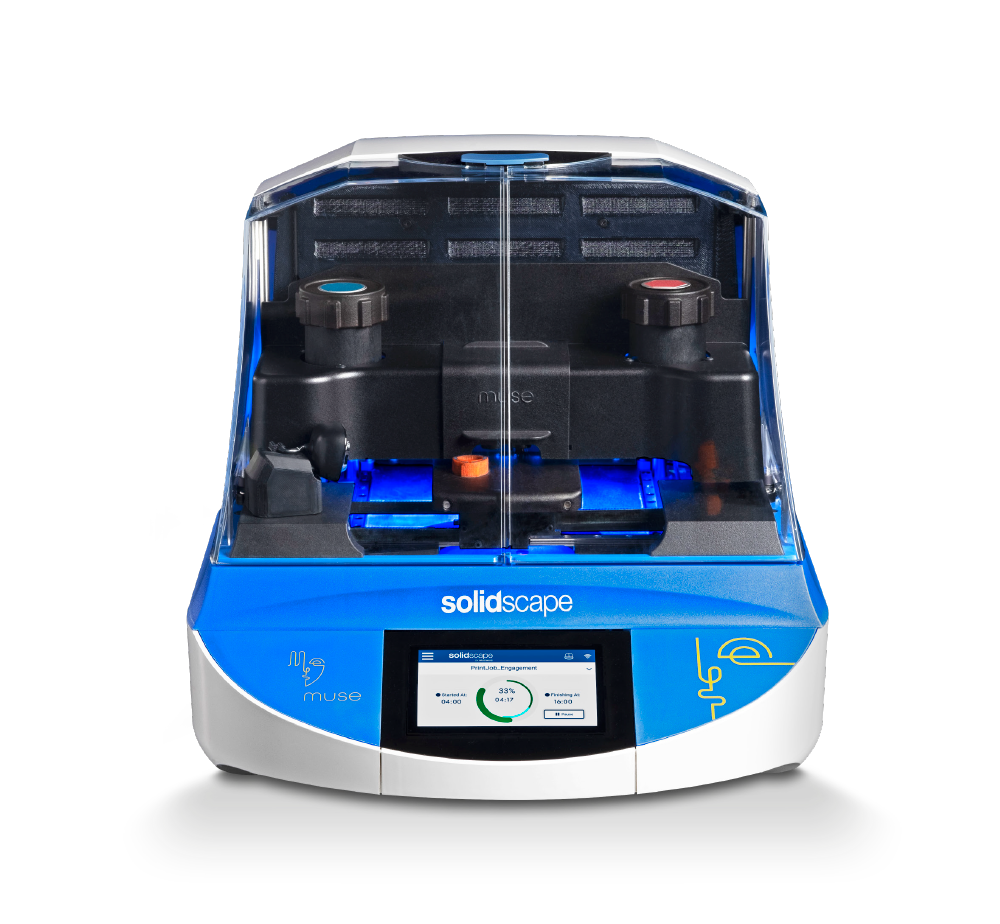It’s been about five years since French 3D printer manufacturer Prodways acquired Solidscape from Stratasys. Now, the wax 3D printing pioneer is making its biggest announcement since the new ownership: the release of the Muse wax 3D printer. Priced under $15,000, the system is meant to democratize a technology that has become ideal for investment casting of dental and jewelry parts. This is an important move both for Solidscape and the jewelry and dental 3D printing markets.
The Muse relies on similar wax jetting technology as pioneered by Solidscape, resulting in 25.4-micron layer thickness. Melt-away supports mean parts can be easily post-processed without auxiliary tools. A petite build volume of 76.2 x 76.2 x 47.7 mm makes it ideal for smaller offices and studios, capable of printing four models in a single build. It is also said to be slower and smaller than Solidscape’s higher-cost machines. Other features include a simple graphic interface and cloud connectivity, with ModelWorks software capable of automatically prepping CAD files for 3D printing and generating support structures.

“Our partners and Jewelers were part of every step of the creation of the Muse, from research to development to testing. We incorporated their most important wants and developed the best machine for custom jewelers,” says Alban D’Halluin, Solidscape CEO. “The common theme in our feedback was accessibility, and that’s what we set out to do. To create the most accessible Solidscape 3D printer for custom jewelers.”
All of this is meant to introduce wax 3D printing to smaller customers who don’t need the output of larger machines. At $15,000, it may also be a convincing entry point into bringing wax printing in-house, where users may have previously relied on outside labs.

As outlined by Scott Dunham, Executive Vice President of Research at SmarTech Analysis, in a recent article, the dental 3D printing industry is evolving toward increased chairside solutions. This means that patients can have crowns and, ultimately even aligners, created all in the office. The jewelry market is following a similar trend in that jewelers are able to obtain increasingly accessible 3D printers for making products in-house. Of course, for both sectors, labs will remain the primary users of AM for the midterm, but solutions like the Muse and low-cost competitors, particularly for jewelry, will be the drivers of this change.
However, these are just one area that will push the jewelry 3D printing sector to reach nearly $1 billion and the dental AM market to hit $9.7 billion by 2031, according to the “3D Printing Jewelry Markets 2023: Market Study and Forecast” and the “3D Printing in Dentistry 2023: Market Study & Forecast” from SmarTech Analysis.
Then, there’s Solidscape and Prodways to consider. Since it was bought by nuclear and robotics company Groupe Gorgé in 2013, it grew quickly, with Groupe Gorgé CEO Raphaël Gorgé at one point aiming for the company to become the number three largest 3D printer manufacturer after 3D Systems and Stratasys.
It released a sub-$100,000 selective laser sintering (SLS) system, partnered with Farsoon to distribute the Chinese firm’s SLS machines, and even developed a directed energy deposition printer for metal. Despite the rapid expansion, Prodways slowed significantly and, like the rest of the industry, was impacted negatively by the COVID-19 pandemic.
Nevertheless, the company continues to be a promising one. With a wide portfolio of technologies, a strong application-focused approach, and a unique 3D printing process for mass production, it would seem primed for success. In 2022, Prodways appointed a new CEO, Michaël Ohana, with experience as Director of the Energy Division and then as a Member of the IBM France Management Committee.
Given all of the merger and acquisition activity that has been taking place recently, one could imagine Groupe Gorgé itself selling Prodways to another entity. AddUp could make sense as a French company focused on metals. It’s also clear that Groupe Gorgé has faced its own difficulties due to the broader financial climate that could force it to make such a move. However, Raphaël Gorgé did seem committed to making 3D printing an essential part of his larger business, so it’s not easy to imagine him making a sale, either.
With that in mind, Prodways may need other avenues for regaining traction. While Solidscape’s latest product may boost that division, it would need to sell a lot of Muses to get back on solid ground.
Subscribe to Our Email Newsletter
Stay up-to-date on all the latest news from the 3D printing industry and receive information and offers from third party vendors.
You May Also Like
Printing Money Episode 17: Recent 3D Printing Deals, with Alex Kingsbury
Printing Money is back with Episode 17! Our host, NewCap Partners‘ Danny Piper, is joined by Alex Kingsbury for this episode, so you can prepare yourself for smart coverage laced...
3DPOD Episode 198: High Speed Sintering with Neil Hopkinson, VP of AM at Stratasys
Neil Hopkinson, a pioneering 3D printing researcher, played a pivotal role in developing a body of research that is widely utilized today. He also invented High Speed Sintering (HSS), also...
3DPOD Episode 197: Ceramics 3D Printing with Johannes Homa, Lithoz CEO
Lithoz is a pioneer in the 3D printing of technical ceramics, initially using a ceramic-loaded stereolithography process and later adopting multiple technologies. Johannes Homa, a researcher turned entrepreneur, discusses his...
High Stakes, High Speed: KVG Acquires 15 Nexa3D HSE 3D Printers to Boost Military Tech
As 3D printing increasingly intersects with defense and military logistics, a new partnership between Nexa3D and mission support logistics firm KVG stresses the growing importance of this technology in strategic...
































